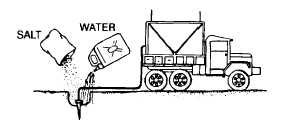Step 3.
Remove terminal lug from grounding stud on Power Entrance Panel.
Step 4.
Tap each peg from side to side using the hammer provided with the kit.
Step 5.
Once a peg is loosened, grasp the cable on both sides of it and pull up to remove.
Step 6.
Continue this procedure until all stakes are removed
Step 7.
Coil cables Place grounding kit and hammer in tool bag.
Section IV. OPERATION UNDER UNUSUAL CONDITIONS
2-4.
UNUSUAL ENVIRONMENT/WEATHER
2-4.1.
Improving soil conductivity. In the event that you must ground your system in a soil that provides a poor soil
conductivity (see table on page 1-5), you can take steps to improve the ground. Increase soil conductivity by adding salt
and water, as shown in figure 2-1. Use water alone if salt is unavailable, Pour the water or mixture directly over the stakes
of the MK-2551A/U. Clean the stakes upon removal if you use salt. Add more water daily.
Figure 2-1
a. Desert.
(1)
In the desert, the MK-2551A/U should work as well as a ground rod unless the sand is very loose. If the
stakes of the MK-2551A/U are not secured well in the sand and are very loose, a ground rod or a ground plate may work
better.
2-5



